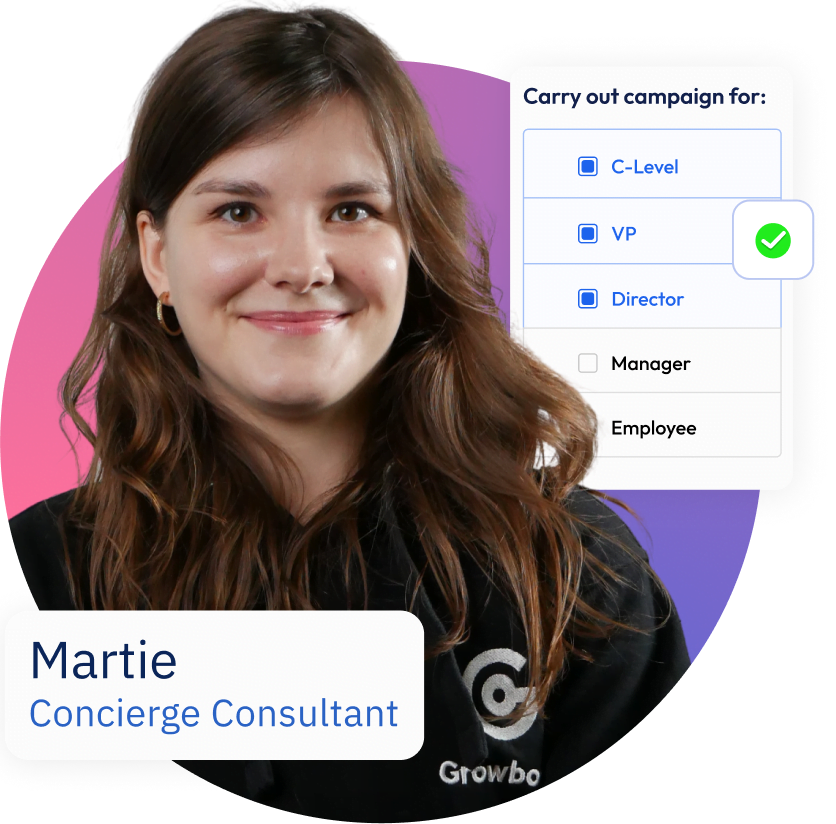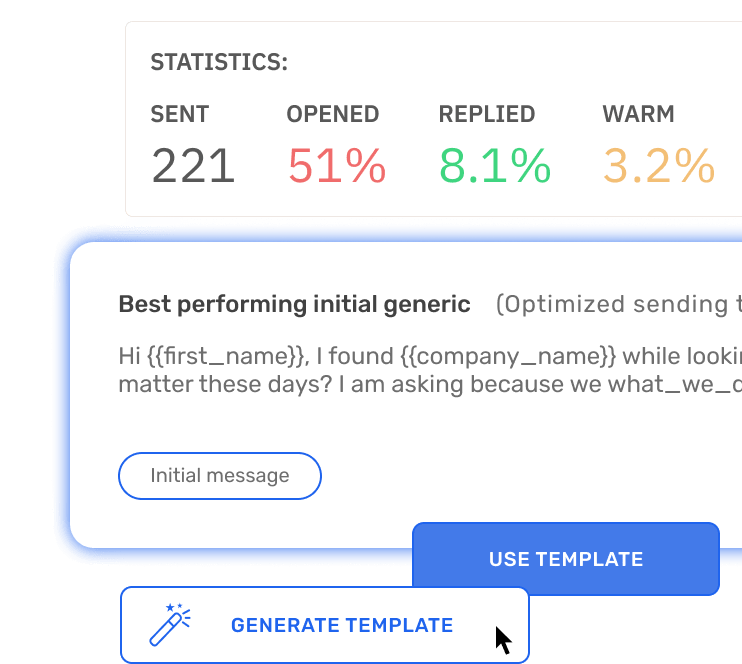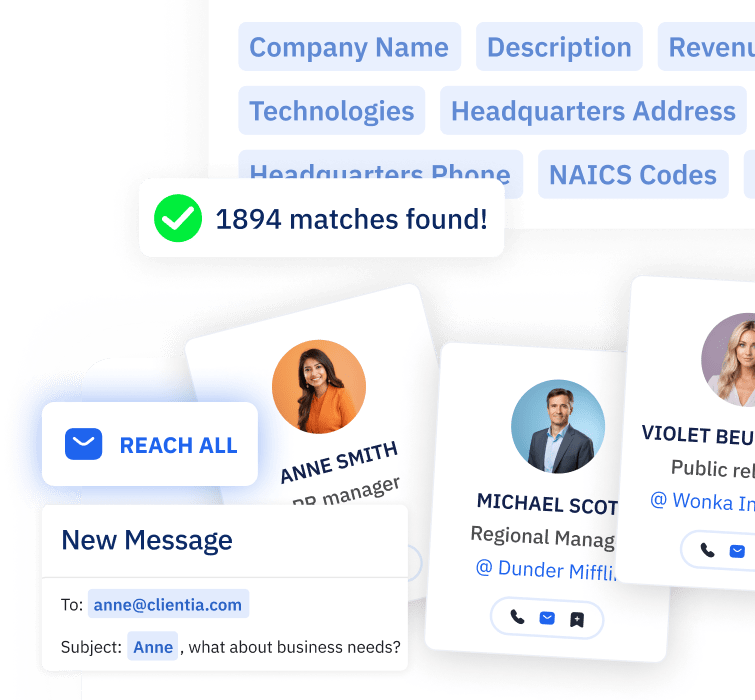Creating a successful cold email campaign is the Holy Grail of a cold mailing. It’s also a pain.
It takes a ton of time, effort, nerves and a slight caffeine overdose to craft a masterpiece.
And yet, when you click send and wait for a tsunami of positive replies, nothing happens… I bet you’ve experienced this at least once.
Working in a company that lives off of cold email campaigns, I’ve learned that there may not be a universal email template that converts for everyone, but with a few simple steps you can achieve great results.
What is a cold email?
Before we jump to the topic of how to write a cold email that will amaze your prospects, let’s explain what it even is.
Along with cold calling, cold emailing is a part of an outreach strategy – the act of reaching out to or contacting someone who has no prior connection to your business.
So basically, a cold email is an initial email you send to a target audience that consists of your potential customers.
That is the biggest difference between cold emailing and email marketing which are sometimes confused. Cold emailing works as a bridge between you and your potential customer who doesn’t know about you yet, whereas email marketing focuses on contacting existing contacts in your database.
As cold email outreach is quite time-consuming, it is usually performed using a cold email software. A tool like this automates most of the tasks required while writing cold emails and sending them in scale.
In a cold email campaign, testing is everything
The first thing that you should always keep in mind, whether this is your first cold email campaign, or you’ve already sent hundreds of messages, is that each target and each prospect is different.
There is no single message that will be effective in every market for every product.
The only thing that will get you consistent results is constant testing. Improve your templates, compare results and remember to only test one part at a time – this way you will be able to see which approach works better.
This may sound a bit overwhelming at first but don’t worry, we’ve outlined the essential guidelines to help you craft a killer cold email campaign.
Where to find prospects for your campaign?
There is one more important thing we need to discuss before we share all the cold email tips you are waiting for and which is a big pain point, largely for people who are just starting out with email outreach. Prospecting, to be precise.
After all, in order to even start the process of cold email writing, you need to know who you even want to send your message to.
Not only should you have a list of contacts you wish to reach out to, but also know enough about them to be able to personalize your sales email so that it corresponds with them.
How to build a valuable prospecting list for your outbound campaign? There are a couple of ways:
- Online research
The internet is one of the best sources of potential contacts that might be interested in your business. Nowadays, social media plays a big role in finding new target groups you can reach out to. LinkedIn is especially handy when it comes to prospecting as you can use advanced search filters to narrow down prospects in your niche. Additionally, you should explore industry-specific lead databases and resources. Looking for a free email addresses directory might also be a good idea if you want to find your prospects online.
- Offline sources
Building your prospecting list can be also done in a traditional, offline way. Let’s take events, conferences, or trade shows as an example. Besides allowing you to network, they also offer the opportunity to spot potential clients. That being said, you should also try contacting existing customers for referrals.
As you can see, identifying the right prospect and sending them a personalized cold email manually is a process that takes a lot of time. Especially if you want to do it at scale.
Thankfully, there are sales prospecting tools like Growbots that automate the prospecting process by providing you with a high-quality contact base and prospect insights that you can use in the email body to attract their attention.
The importance of the first email
Before we discuss exactly how to turn your cold email messages into killer cold emailing, it’s necessary to establish why your first email message is so important.
Your first email is your introduction to a prospective customer, and you have two seconds to hook their interest. Seriously, studies show that over 50% of readers spend less than two seconds looking at an email.
When you open an email from someone you don’t know, it’s unlikely that you’re going to read something that’s wall-to-wall text. Far too often people tend to overshare in cold email messages, thinking that it will establish a connection with the potential customer. My advice is to think about what you would share in person with a lead.
Most likely, you’re not going to say, “Hi, my name is [Your Name],” and then go on a ten-minute explanation of your family, your job and why the person you’re talking to needs your product before even letting them give you their name.
The same is true with well crafted cold email messages. Keep them short, sweet and to the point while still conveying what you need your lead to know, and you’ll be a killer cold emailing expert in no time.
Reach More with Less Effort
Connect with Potential Clients at scale
- AI message generator
- E-mail verification
- Multichannel sequences
- A/B testing
How to write a cold email?
Now that we have established what a cold email is, where to look for your prospects, and why the first email is so crucial, let’s dive into the actual trips on how to write a cold email.
After using this guide, you should be able to craft several predictable revenue email templates that you can use repeatedly for a variety of clients.
Here’s how to create reusable killer email templates you’ll use again and again:
Step 1: The “From” line
An email’s “from” line is just as crucial as its body, and that’s because it plays a very important role. Since it shows the recipient exactly who sent the email, it has a huge impact on their first impression.
More often than not, your recipient will use the from line to decide whether to even open your email. How should you then structure your from line?
The right sender name for your cold outreach campaign depends on the context of your message, the target audience you want to contact, and the goal you want to accomplish with your email.
There are at least 5 possible forms of the from line:
- First name
- First name + Last name
- First name + Last name, Title
- First name + Company name
- First name + Last name + Company name
Step 2: Subject line
The ultimate goal of your cold email campaign is to turn a cold prospect into a warm lead. But before you can persuade anyone with a well-written email copy and a great offer, you first have to convince them to open your email.
And that’s why a subject line can either save or sink your whole cold email campaign. There are a couple of good practices when it comes to writing a good subject line. Make sure you never forget to:
- Personalize – If you include the prospect’s first name and/or their company name in the subject line, it’s less likely that email clients will flag your message as spam. Plus, it will grab a prospect’s attention if they see their name among a sea of impersonal email.
- Keep it as short as possible – It’s best to keep it less than five words. Long subject lines look salesy.
- Never mislead your prospects – It may give you higher open rates but once they see that your email and subject line have nothing in common, they will either: a. completely lose interest in your product, b. report you as spam, or c. give you bad press.
- Avoid using ‘salesy’ words – Terms such as ‘buy’ or ‘offer’ trigger spam filters and that’s not how you want to be perceived. You can check which words should be avoided here.
- Make it casual – You can write a question or an unfinished sentence. Another idea is writing subject lines completely in lowercase letters.
- Send up to 3-4 messages in one thread – Try to make it continuous but once you see that one approach is not working switch it to something a bit different. Remember, always be testing.
The way you structure your subject line has a big impact on whether your email will land in the recipient’s inbox or spam folder. If you want to learn more about that, we discuss the topic and the words to avoid in email subject lines in our other article.
Make sure that each of your follow up emails builds up on the value your main email includes.

Polly Korolova
Strategy Consultant at Growbots

Step 3: The Preview
The subject line is only one element that encourages a prospect to open your email. Another crucial part is the preview. The preview is the opening of your email that’s already visible in the inbox before clicking on the message. It’s crucial for getting your message opened so remember to:
- NEVER start with describing you or your company! – Put yourself in the recipient’s shoes for a second. Would you care about some stranger’s name and occupation? Probably not.
- Start with something you have in common – mention a conference you both attended, the same type of company, anything that will make them feel like you’re not just a random person but someone who understands them. When they see that in their inbox they will be more willing to read your email.
- Find a personal touch – Write like their friend, not a salesperson. One technique we like to use is to write our email to a friend we actually know first. This will help keep the content real and conversational.
- Address a problem – Mention a problem which can be solved by your product which shows you understand and can relate to their pain. This approach is called the ‘event’ and is one of the most effective in cold mailing. It appeals to both a recipient’s head and heart – you can make their job easier and save them stress and time.
Step 4: Intro
Cold email introduction is an extension of the preview of your email. Your opening line needs to hold your recipient’s attention and make them read further than the first two lines.
Considering the downward trend when it comes to people’s attention span, your email’s intro shouldn’t be longer than 1 sentence.
It should, however, include a message that will correspond with the receiver, their expertise, work, company, or the pain point that they might be dealing with.
This is how you hit that sweet spot and grab your audience’s attention. Now you’re ready to work on the body of your cold email.
Seek, pick, and reach
Connect with your potential customers
- 180m+ contacts
- Advanced filtering
- Multichannel sequences
- CRM integrations
Step 5: The Body
After writing the opening line it’s time to get to the meat of the message – the body. Most people don’t read emails (especially sales emails) thoroughly.
How do we know that?
One day I sent a draft of a cold email campaign with an internal note in the message to 300 people (I know, it was stupid. Lesson learned). But I still received replies from people who praised my message.
Conclusion?
Prospects just skim emails and decide if your offer is worth their time if something manages to catch their attention. So remember:
- Keep it as short as possible – most of the people check their email on mobile devices during a busy day and don’t bother to even skim long messages. Your first contact should be about getting their attention.
- Use more paragraphs – They make the message clearer, easier to read, and help you keep it better organized. The recommendation is 2 paragraphs per email and a clear call-to-action at the end.
- Use short, simple sentences – Three simple sentences are easier to tackle than one long, elaborate sentence. This is especially true for non-technical readers in your market.
- Try to keep it casual – Try to make it sound like you’re sending a message to your friend or colleague. Avoid using negative terms as they are counter-effective. Show the profits your product can generate by creating a positive image of your company and product. Most importantly, don’t use salesy words that can result in your emails being flagged as spam. We share tips on how to avoid spam filters when sending cold emails in another article.
Step 6: The Pitch
Another critical component of your email copy is the pitch.
Your pitch is the heart of your email, and you need it to convey why your lead should be actively considering your product. Using the below tips should positively impact the response rates of your campaign:
- Sell value – Remember to always put emphasis on ‘you’ and ‘your’ rather than ‘I’, ‘me’, or ‘our’.
- Keep it casual – Just like the rest of the message.
- Focus on BENEFITS, not features – Emails should serve the customer not the product. So show the results that your product will deliver and not just the fancy bells and whistles of the product. Start with the “why” not the “how”.
- Don’t reveal all of your cards at once – or in other words, don’t try to list every single benefit of every service or product you offer. If you do, it won’t be clear what the most important point is and you won’t have anything new to add in the following messages.
- Use numbers – They stand out in plain text, draw attention, and give solid information about your product.
- Give social proof – Show how you’ve helped other companies, preferably ones that are similar to your prospect’s. Talk about how you specifically solved their problems or what results you achieved for them.
- Don’t bury it – Once in a great while I’ll receive a great cold email, but the pitch is buried somewhere within the body. Make sure your pitch stands out so the lead knows why you’re contacting them.
Step 7: The Call-To-Action
After you’ve addressed the problem and shown the solution, you need to guide the prospect to where they can learn more about your offer (and convert). It’s time for your Call-To-Action.
Your Call-To-Action (or CTA) should be:
- Short – Choose one consistent CTA, it’s easier for the receiver to know what to do.
- Interest-based – CTAs focused on booking calls or meetings are becoming less and less popular. Instead, try something like: Would you be interested in learning more / see how it works?
- Specific – The more specific you are, the more tangible the offer becomes. The more tangible the offer, the more likely someone is to take action.

Step 8: The signature
Your email signature is very important as it tells the recipient who you are and where they can find more information about you and/or your company.
However, you should try to keep it as simple and short as possible.
The name, surname, position, and company you work for as well as your email address are sufficient.
To keep your deliverability high, remember to not include more than one link in your signature (unsubscribe link or a link to your website).
Step 9: Check the length of the email
Your initial cold email should be short and to the point. As we mentioned above, the current recommendation is to include 2 paragraphs per email and a clear call-to-action at the end.
We recommend writing 2-5 sentences of no more than 200 words in total.
Step 10: Follow ups
No matter how good your personalized cold email is, you should always remember to include a couple of follow-ups in your outreach strategy.
Why is that?
Sometimes your initial email might get lost in your prospect’s inbox or they might simply forget to reply to you. At Growbots, we recommend our clients to start with a very short first follow up email.
It can be as simple as “Any thoughts?”. How should the rest of the follow-up messaging be structured?
There are a couple of follow-up strategies you can test.
Showcasing a new angle of your product or another pain point that the prospect can have. A follow up like that should:
- Slightly different to the first message.
- Show various benefits of your product.
- Short but to the point, and as relevant as the other messages.
Reminding the recipients of your previous messages as your email might have got stuck somewhere in the inbox (if you want to read more about the best time to send cold emails, we’ve written another article about it). In this case, send:
- A short message to move you up in the prospects’ inbox and remind them about your offer.
- Use a polite but firm tone.
- Possibly link to an article of yours; maybe something valuable for your recipient and relevant to your messages.
Teasing and giving them a glimpse of how your solution could help them.
- Show potential value for your prospect. For instance, provide them with an opportunity for a free trial account.
- Ensure that they understand the benefits of your solution before they purchase it.
Your offer won’t appeal to everyone, and most people won’t even reply to your message. This is why you should include a break-up email at the end of your thread.
Let the recipient choose between two options: ask directly whether they’re interested or do not want to see your offer. Then tell them you will not message them again.
If you have not used it before, you can also add one more killer pitch at the end.
If you’re scheduling a lot of cold emails, it might be a good idea to use an outreach automation tool – this way you don’t have to remember about sending each follow up email manually. Automated follow ups also have another advantage – they will automatically stop when the receiver responds.
Reach More with Less Effort
Connect with Potential Clients at scale
- AI message generator
- E-mail verification
- Multichannel sequences
- A/B testing
Examples
Looking for a cold email template that could inspire your next campaign? Following you will find one of many examples of well-structured cold email examples that we share with our clients at Growbots.
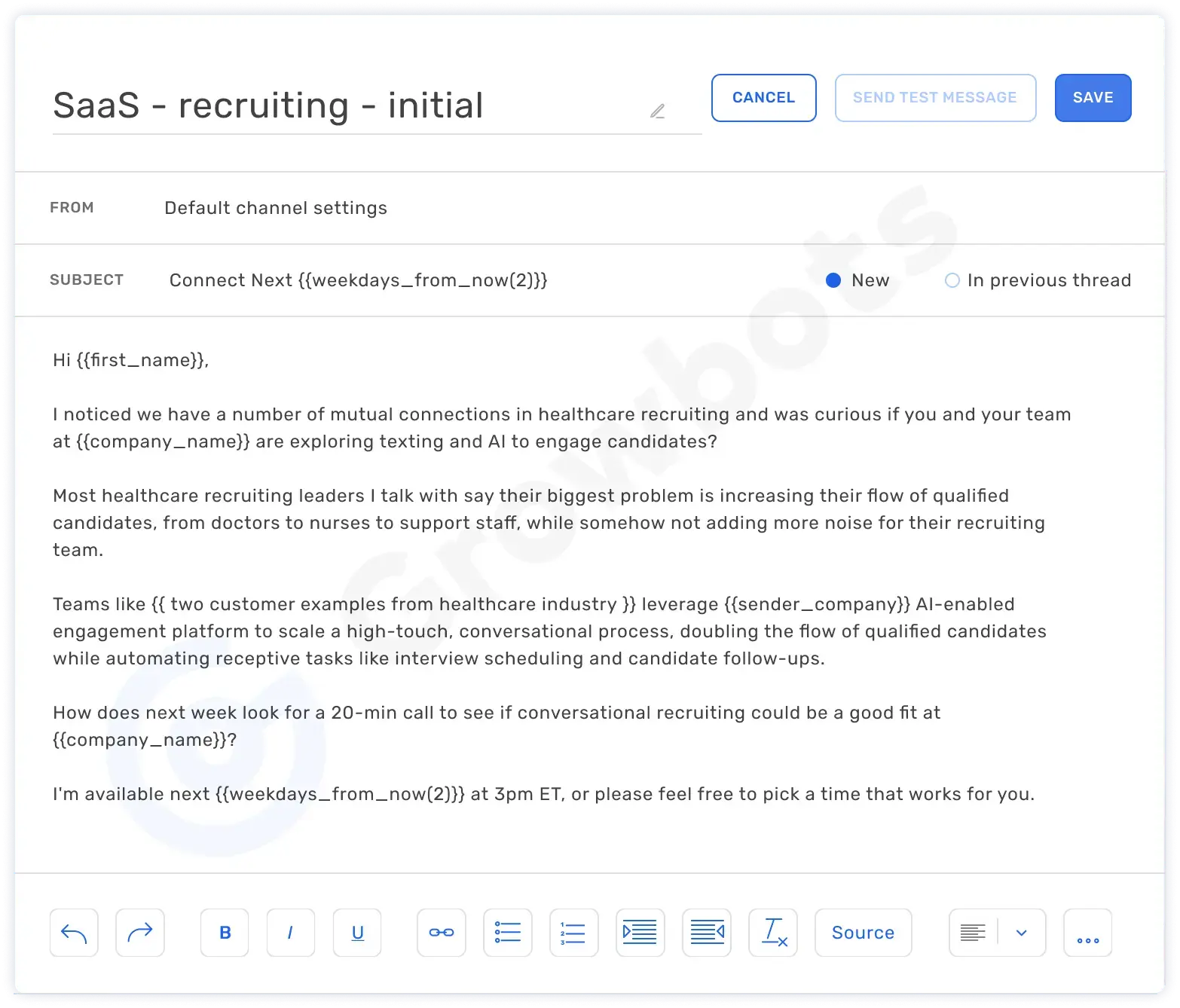
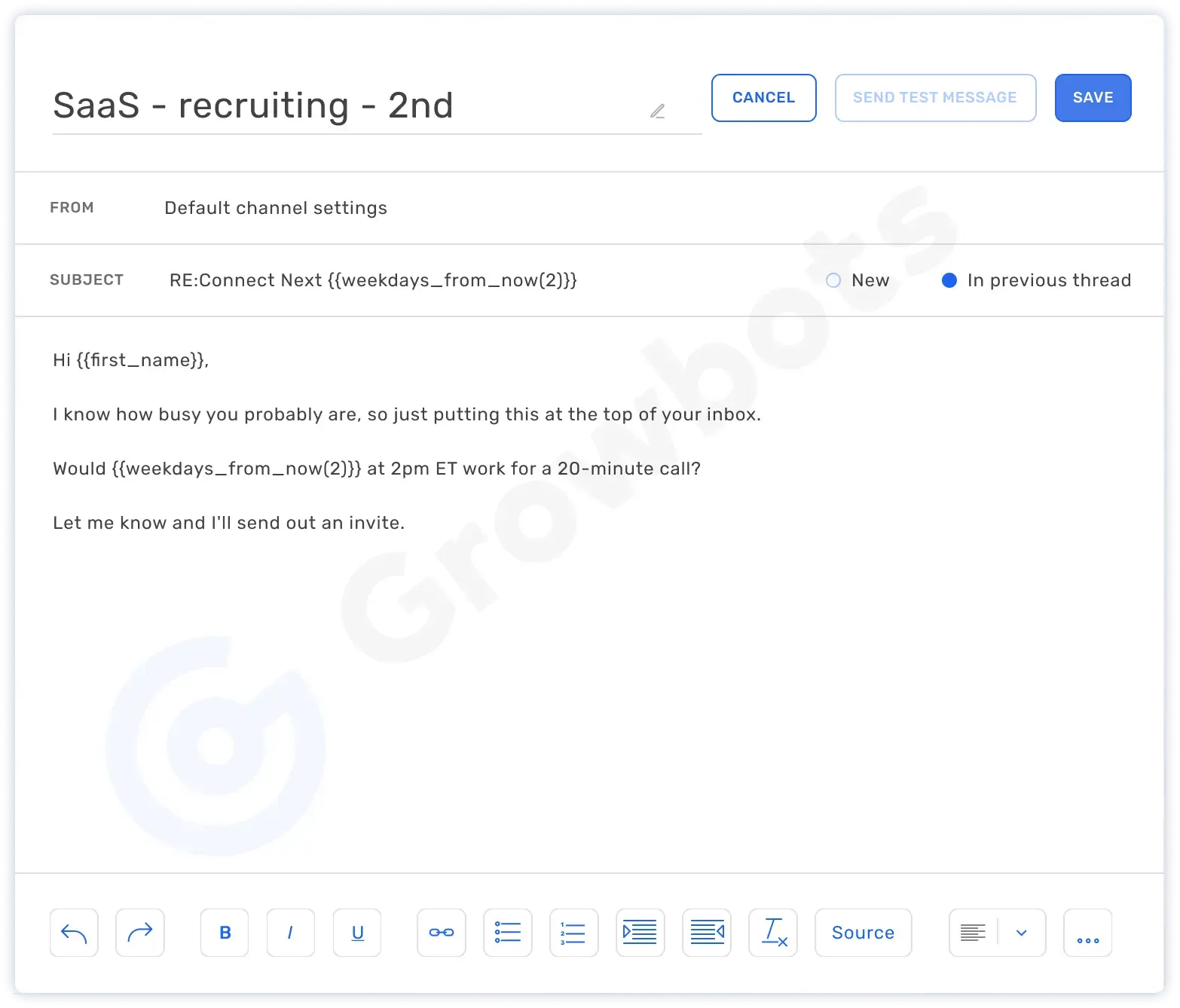
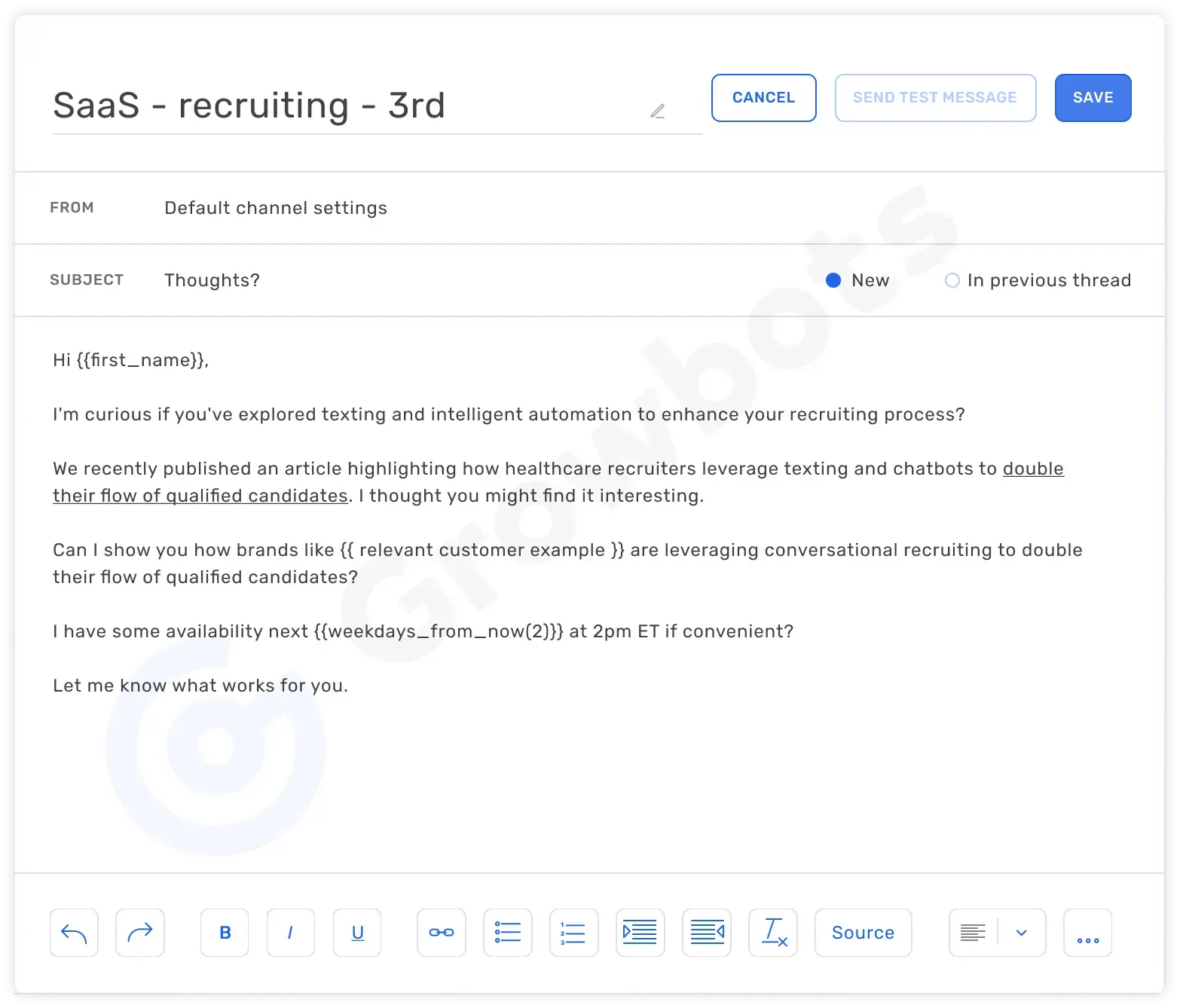

Would you like another cold email example? If you’re looking for a cold email template for your specific industry, make sure to start a free Growbots trial and explore our cold email template database.
Best Practices
In addition to the tips mentioned above, there are also other cold email practices you should follow:
- The form of your cold email should be conversational and effortless. The language you should use should be as natural as possible – your prospects want to read something as if they heard it from you.
- You should follow some rules when structuring your subject line (e.g. including prospect’s company name in it and avoiding salesy words).
- The shorter the better. Based on our experience, the most important part of any cold email is the opening line. You should include something that will attract your recipients’ attention in it.
- Remember to research the prospect you’re reaching out to. Each target audience has specific needs and paint points. The value in your cold email should address them.
- Focus on providing the prospect with the opportunity to help them with something.
- Double check your ”from” line before sending your cold email campaign.
- Make sure to include an unsubscribe link in your email – you want your prospects to have the opportunity to sign out of receiving further communication from you.
Putting it all together
Writing a killer first email message is hard. But by following our guidelines laid out above, you’ll be well on your way to setting up an email campaign that converts centered around killer email templates.
After going through these steps, your cold email message should be straightforward, easy to read, and will follow all the rules of great predictable revenue email templates.
To sum up, your email should be:
- Easy to read & scan for busy readers
- Personalized to your prospect
- Focused on one major problem they’re facing
- Focused on one main benefit & solution for that problem
- Written in a casual style
- Clear about the next step
Remember that you want to craft predictable revenue email templates that you can use over and over again.
This will mean making changes to them not only based on the client you’re reaching out to, but also on what your company has recently released.
I’ve seen far too many people create a really killer email template only for them to use it years later, plugging a product that’s out of date.
Finally, keep track of who you send emails to.
Sometimes a person isn’t looking for a new product right now, but they might be next year.
Make sure that you don’t use the same cold emailing template on them if you choose to reach out again. This is one instance where you don’t want to create feelings of deja-vu.
Hopefully now you know how to write cold emails yourself so that they compel your target audience. However, if you still feel unsure, we can help you!
Generating a personalized cold email template with the help of AI
If you are still struggling with writing your cold email, we have good news.
At Growbots, we have recently introduced an AI Template Generator which enables you to generate a truly personalized email template that will entice your recipients. All that without having to use a different tool outside Growbots.
How does it work?
- Go to Growbots and choose the audience you want to send your campaign to.
- In the Email Template section, select “Generate template”.
- Fill in a form specifying the email purpose, the problem you’re solving, as well as your solution and industry.
- Using your input, our tool will generate a compelling email template ready to be used in your campaign.
Start a free trial or login to your existing Growbots account and see how easy it is to create a cold email that will help you reach your business goals.
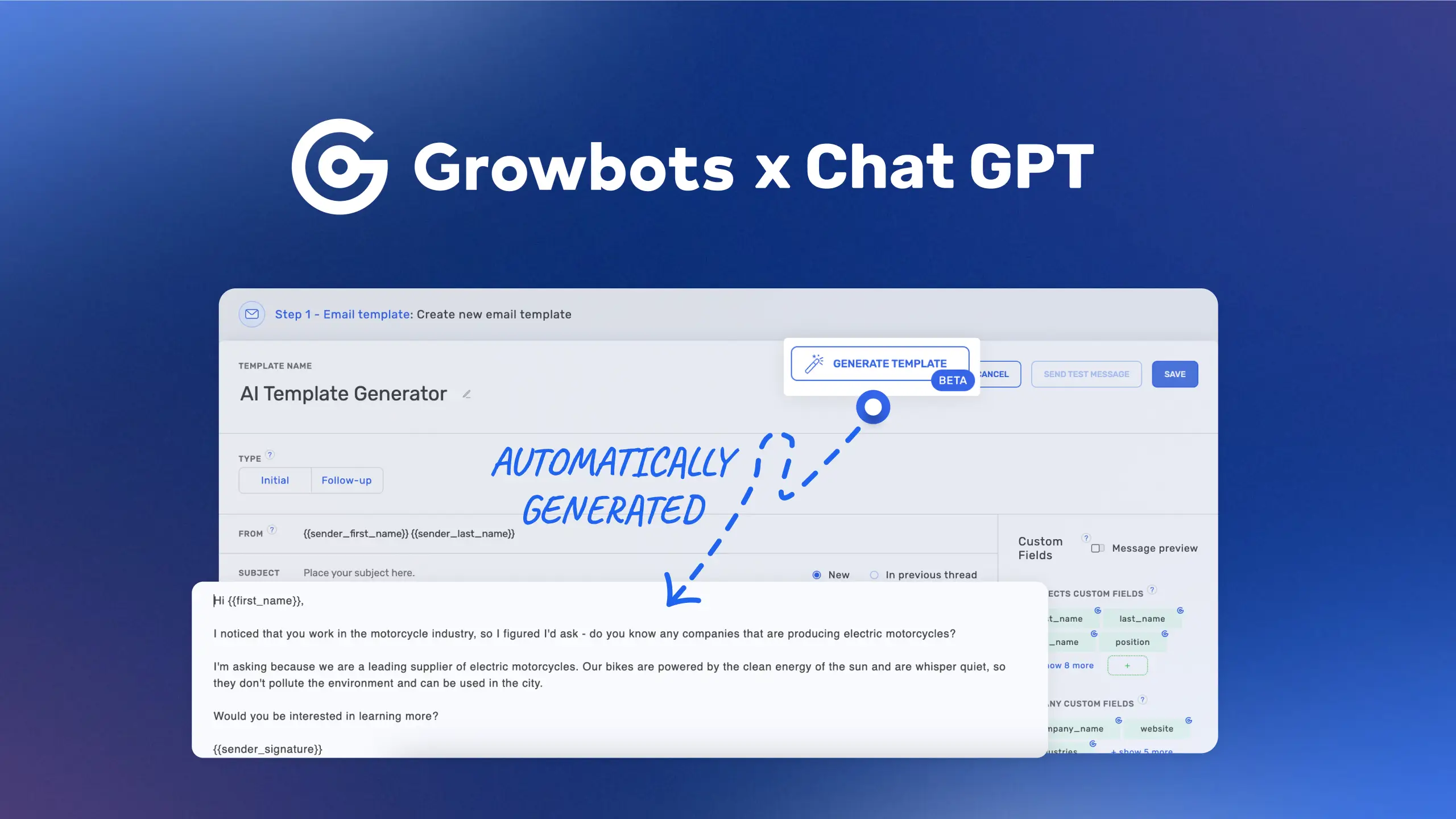
How else Growbots could help you
If you only take one piece of advice from this post it is this: write something interesting above all else. Remember, the only purpose of your campaign is to spark interest in your recipient.
You can worry about making a sale later, right now you are simply interested in starting a conversation.
Have you already got a good first message written by yourself or generated with our AI Template Generator?
Complete the rest of your campaign by adding follow-up messages. You can check out our guide to follow-ups here.

Polly Korolova
Strategy Consultant at Growbots

















